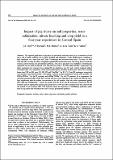Por favor, use este identificador para citar o enlazar a este item:
http://hdl.handle.net/10261/28776COMPARTIR / EXPORTAR:
 SHARE SHARE
 CORE
BASE CORE
BASE
|
|
| Visualizar otros formatos: MARC | Dublin Core | RDF | ORE | MODS | METS | DIDL | DATACITE | |

| Título: | Impact of pig slurry on soil properties, water salinization, nitrate leaching and crop yield in a four-year experiment in Central Spain |
Autor: | Díez López, José Antonio CSIC; Hernáiz, Pedro J. CSIC; Muñoz, M. J.; Torre, A. de la; Vallejo, Antonio | Palabras clave: | Irrigation Leaching Maize Nitrate Pig slurry Soil salinity Aquifer pollution |
Fecha de publicación: | 2004 | Editor: | British Society of Soil Science | Citación: | Soil Use and Management 20:444-450 (2004) | Resumen: | The repeated application of pig slurry to agricultural soils may result in an accumulation of salts and a risk of aquifer pollution due to nitrate leaching and salinization. Under Mediterranean conditions, a field experiment on a sandy loam soil (Typic Xerofluvent) was performed with maize (Zea mays) in 1998, 1999 and 2001 to study the effects of applying optimal (P1) and excessive rates (P3) of pig slurry on soil salinization, nitrate leaching and groundwater pollution. The rate of pig slurry was established considering the optimal N rate for maize in this soil (170, 162 and 176 kgNha21 for 1998, 1999 and 2001, respectively). Pig slurry treatments were compared to an optimal N rate supplied as urea (U) and a control treatment without N fertilizer (P0). The composition of the slurries showed great variability between years. Mean NO3 2 leaching losses from 1998 to 2001 were 329, 215, 173 and 78 kgNha21 for P3, P1, U and P0 treatments, respectively. The amount of total dissolved salts (TDS) added to the soil in slurry application between 1998 and 2001 was 2019 kgTDSha21 for the P1 treatment and 6058 kgTDSha21 for the P3 treatment. As a consequence, the electrical conductivity (EC) of the slurry-treated soils was greater than that of the control soil. The EC correlated significantly with the sodium concentration of the soil solution. Over the entire experimental period, 2653, 2202 and 2110 kg Na ha21 entered the aquifer from the P3, P1 and P0 treatments, respectively. The P3 treatment did not significantly increase grain production in 1999 and 2001 compared with that achieved with the optimal N rate treatment (P1). This behaviour shows the importance of establishing application guidelines for pig slurry that will reduce the risk of soil and groundwater pollution. | Descripción: | 7 pages, figures, and tables statistics. | Versión del editor: | http://dx.doi.org/10.1079/SUM2004283 | URI: | http://hdl.handle.net/10261/28776 | DOI: | 10.1079/SUM2004283 | ISSN: | 0266-0032 |
| Aparece en las colecciones: | (ICA) Artículos (INIA) Artículos |
Ficheros en este ítem:
| Fichero | Descripción | Tamaño | Formato | |
|---|---|---|---|---|
| SUM purin 2004.pdf | 171,4 kB | Adobe PDF |  Visualizar/Abrir |
CORE Recommender
WEB OF SCIENCETM
Citations
31
checked on 28-feb-2024
Page view(s)
397
checked on 23-abr-2024
Download(s)
537
checked on 23-abr-2024
Google ScholarTM
Check
Altmetric
Altmetric
NOTA: Los ítems de Digital.CSIC están protegidos por copyright, con todos los derechos reservados, a menos que se indique lo contrario.
